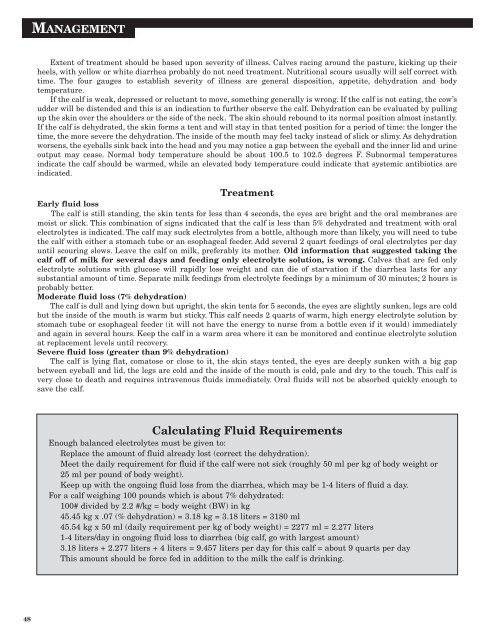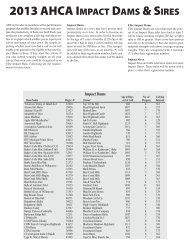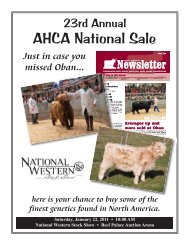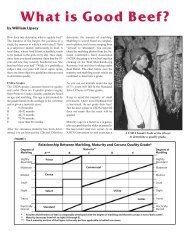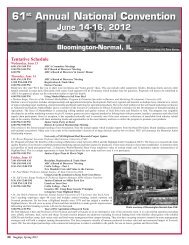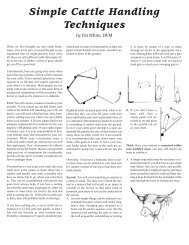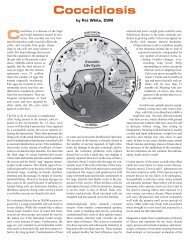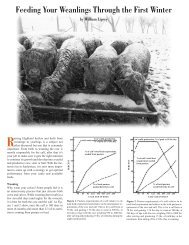The Bagpipe - American Highland Cattle Association
The Bagpipe - American Highland Cattle Association
The Bagpipe - American Highland Cattle Association
Create successful ePaper yourself
Turn your PDF publications into a flip-book with our unique Google optimized e-Paper software.
48<br />
MANAGEMENT<br />
Extent of treatment should be based upon severity of illness. Calves racing around the pasture, kicking up their<br />
heels, with yellow or white diarrhea probably do not need treatment. Nutritional scours usually will self correct with<br />
time. <strong>The</strong> four gauges to establish severity of illness are general disposition, appetite, dehydration and body<br />
temperature.<br />
If the calf is weak, depressed or reluctant to move, something generally is wrong. If the calf is not eating, the cow’s<br />
udder will be distended and this is an indication to further observe the calf. Dehydration can be evaluated by pulling<br />
up the skin over the shoulders or the side of the neck. <strong>The</strong> skin should rebound to its normal position almost instantly.<br />
If the calf is dehydrated, the skin forms a tent and will stay in that tented position for a period of time: the longer the<br />
time, the more severe the dehydration. <strong>The</strong> inside of the mouth may feel tacky instead of slick or slimy. As dehydration<br />
worsens, the eyeballs sink back into the head and you may notice a gap between the eyeball and the inner lid and urine<br />
output may cease. Normal body temperature should be about 100.5 to 102.5 degrees F. Subnormal temperatures<br />
indicate the calf should be warmed, while an elevated body temperature could indicate that systemic antibiotics are<br />
indicated.<br />
Treatment<br />
Early fluid loss<br />
<strong>The</strong> calf is still standing, the skin tents for less than 4 seconds, the eyes are bright and the oral membranes are<br />
moist or slick. This combination of signs indicated that the calf is less than 5% dehydrated and treatment with oral<br />
electrolytes is indicated. <strong>The</strong> calf may suck electrolytes from a bottle, although more than likely, you will need to tube<br />
the calf with either a stomach tube or an esophageal feeder. Add several 2 quart feedings of oral electrolytes per day<br />
until scouring slows. Leave the calf on milk, preferably its mother. Old information that suggested taking the<br />
calf off of milk for several days and feeding only electrolyte solution, is wrong. Calves that are fed only<br />
electrolyte solutions with glucose will rapidly lose weight and can die of starvation if the diarrhea lasts for any<br />
substantial amount of time. Separate milk feedings from electrolyte feedings by a minimum of 30 minutes; 2 hours is<br />
probably better.<br />
Moderate fluid loss (7% dehydration)<br />
<strong>The</strong> calf is dull and lying down but upright, the skin tents for 5 seconds, the eyes are slightly sunken, legs are cold<br />
but the inside of the mouth is warm but sticky. This calf needs 2 quarts of warm, high energy electrolyte solution by<br />
stomach tube or esophageal feeder (it will not have the energy to nurse from a bottle even if it would) immediately<br />
and again in several hours. Keep the calf in a warm area where it can be monitored and continue electrolyte solution<br />
at replacement levels until recovery.<br />
Severe fluid loss (greater than 9% dehydration)<br />
<strong>The</strong> calf is lying flat, comatose or close to it, the skin stays tented, the eyes are deeply sunken with a big gap<br />
between eyeball and lid, the legs are cold and the inside of the mouth is cold, pale and dry to the touch. This calf is<br />
very close to death and requires intravenous fluids immediately. Oral fluids will not be absorbed quickly enough to<br />
save the calf.<br />
Calculating Fluid Requirements<br />
Enough balanced electrolytes must be given to:<br />
Replace the amount of fluid already lost (correct the dehydration).<br />
Meet the daily requirement for fluid if the calf were not sick (roughly 50 ml per kg of body weight or<br />
25 ml per pound of body weight).<br />
Keep up with the ongoing fluid loss from the diarrhea, which may be 1-4 liters of fluid a day.<br />
For a calf weighing 100 pounds which is about 7% dehydrated:<br />
100# divided by 2.2 #/kg = body weight (BW) in kg<br />
45.45 kg x .07 (% dehydration) = 3.18 kg = 3.18 liters = 3180 ml<br />
45.54 kg x 50 ml (daily requirement per kg of body weight) = 2277 ml = 2.277 liters<br />
1-4 liters/day in ongoing fluid loss to diarrhea (big calf, go with largest amount)<br />
3.18 liters + 2.277 liters + 4 liters = 9.457 liters per day for this calf = about 9 quarts per day<br />
This amount should be force fed in addition to the milk the calf is drinking.


